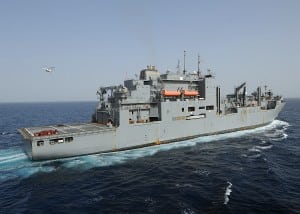This week the U.S. and India said they are starting to consider expanding defense cooperation by potentially using Indian shipyards to repair and maintain U.S. Military Sealift Command ships.
The announcement came after Secretary of State Anthony Blinken and Secretary of Defense Lloyd Austin hosted the fourth U.S.-India 2+2 Ministerial Dialogue with their Indian counterparts.
“To further enhance defense industrial cooperation in the naval sector, both sides agreed to explore possibilities of utilizing the Indian shipyards for repair and maintenance of ships of the U.S. Maritime Sealift Command (MSC) to support mid-voyage repair of U.S. Naval ships,” the State Department said in a statement released jointly with the government of India following the dialogue.
That part of the statement came after the governments said they will both explore and further promote the means to encourage reciprocal participation of U.S. and Indian vendors in each other’s supply chains.

“Acknowledging India’s focus on developing its domestic capabilities and helping to ensure reliable defense supplies, the Ministers committed to work closely across their respective governments on co-production, co-development, cooperative testing of advanced systems, investment promotion, and the development of Maintenance Repair and Overhaul (MRO) facilities in India,” the statement said.
When asked at a Pentagon press briefing to comment on India repairing U.S. vessels, the Defense Department responded by quoting the joint statement with no additional information.
MSC is the Navy component of U.S. Transportation Command, which is responsible for providing transportation for national security needs. MSC operates about 125 civilian-crewed ships that replenish Navy ships, provide logistical support and strategic sealift, and strategically pre-position combat cargo around the world.
MSC ship classes include Spearhead-class expeditionary fast transport ships (EPFs); Lewis-B. Puller-class expeditionary sea base ships (ESBs); the two Mercy-class hospital ships; Lewis and Clark-class dry cargo ships (T-AKE); the John Lewis-class fleet replenishment oilers (T-AO), and the Navajo-class towing, salvage and rescue ships, among many others.